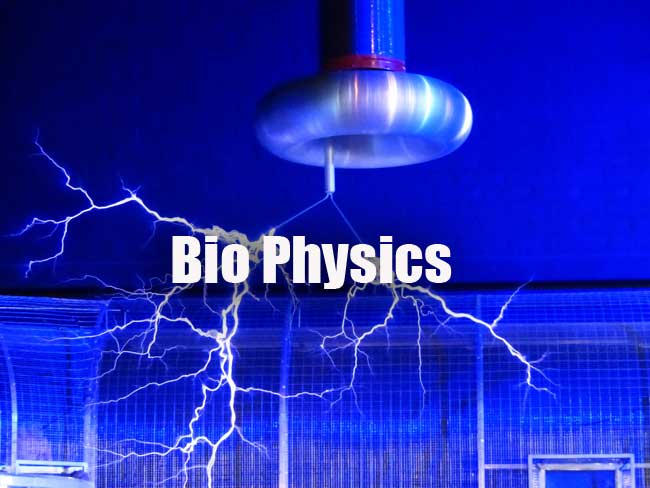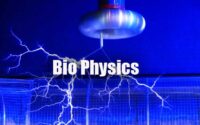Biophysics MCQS
Biophysics MCQS paper for the written examination is given below. Candidates who are looking for Biophysics exam MCQS paper can find in this section. The applied candidates who are getting prepared for the Biophysics can view this page for the Biophysics Last Ten Years MCQ Papers.

Download the Biophysics MCQ & Solutions & make it as a reference for your exam preparation. Take advantage of these Biophysics MCQS Papers in a proper manner to get qualifying Marks. Last 5 years Biophysics MCQ Papers provided here. Candidates who are applied for the above exam can check and download the Biophysics MCQS Papers from here.
MCQs on Biophysics
1. How does Ras oncogene contribute to cancers ?
(1) It codes for an anti-apoptotic protein, produced in abnormally large amounts.
(2) It codes for a GTPase switch protein, which in its mutated form cannot be switched off.
(3) It codes for a transcription factor produced abnormally in large amounts.
(4) A growth factor that is continually active is encoded in its truncated form.
2. Which of the following could be coded by a tumor-supressor gene ?
(1) A protein that helps prevent progression through cell cycle.
(2) A protein that helps prevent apoptosis.
(3) A protein that codes for a DNA repair enzyme.
(4) A protein that forms part of a growth factor signalling pathway.
3. Programmed cell death is termed as
(1) Metastasis
(2) Apoptosis
(3) Proliferation
(4) mitotic termination
4. Oncogenes do not encode for
(1) Trans-membrane protein receptors
(2) growth factors
(3) DNA-dependent RNA polymerase
(4) Cytoplasmic G-proteins and protein kinases
5. Proto-oncogenes can be transformed to oncogenes by all of the following mechanisms except
(1) elimination of their start signals for translation
(2) during a viral infection cycle
(3) chromosomal rearrangements
(4) chemically induced mutagenesis
6. On a Ramachandran plot the ψψ values for haemoglobin would be in
(1) the first quadrant
(2) the second quadrant
(3) the third quadrant
(4) the fourth quadrant
7. The portion of proteins having the highest mobility is
(1) α-chelices
(2) β-sheets
(3) peptide bonds
(4) surface side chains
8. The major element of secondary structure in myoglobin and haemoglobin is
(1) the β-strand
(2) the α-helix
(3) the 310 helix
(4) All of the above
9. Molecular dynamics simulations can be used to
(1) follow the time dependence of a biomolecule
(2) calculate thermodynamics quantities
(3) Dock ligands
(4) All of the above
10. Secondary structure is defined by
(1) Hydrogen bonding
(2) Vander walls forces
(3) Covalent bonding
(4) Ionic bonding
11. Which of the following does not affect the stability of an a-helix ?
(1) Electrostatic repulsion
(2) Bulkiness
(3) Interaction between R-groups spaced three residues apart
(4) Occurrence of alanine and glycine residues
12. Which of the following is not correct about the NMR ?
(1) It stands for Nuclear Magnetic Resonance
(2) NMR spectroscopy detects spinning patterns of atomic nuclei in an electric field.
(3) NMR spectroscopy detects spinning patterns of atomic nuclear in a magnetic field
(4) Protein samples are labelled with radioisotopes such as 13 C and 15 N.
13. Which of the following is not correct about the X-ray crystallography ?
(1) In X-ray protein crystallography, proteins need to be grown into large crystals in which their positions are fixed in a repeated, ordered fashion.
(2) The protein’ crystals are illuminated with an intense X-ray beam.
(3) The X-rays are deflected by the electron clouds surrounding the atoms in the crystal producing a regular pattern of diffraction.
(4) The protein crystals are illuminated with the intense infrared beam.
14. Which of the following is not correct ?
(1) The rigid double bond structure forces atoms associated with the peptide bond to lie in the same plane, called the dipeptide plane
(2) A peptide bond is actually a partial double bond owing to shared electrons between O=C-N atoms
(3) Because of the planer nature of the peptide bond and the size of the R-groups, there are considerable restriction on the rotational freedom by the two bonded pairs of atoms around the peptide bond
(4) The angle of rotation about the bond is referred to as the dihedral angle (also called as torsional angle)
15. Which of the following is not correct about the α-helices ?
(1) An α-helix has a main chain backbone conformation that resembles a cork screw
(2) Nearly all known a-helices are right-handed, exhibiting a leftward spiral form
(3) Nearly all known a-helices are right-handed, exhibiting a rightward spiral form
(4) In right-handed helix there are 3.6 amino acids per helical turn
16. Osmotic pressure of 1 mole of ideal solute relative to pure water is
(1) 6.5 atm
(2) 22.4 atm
(3) 4 atm
(4) 1 atm
17. What provides most of the energy that is used to maintain a normal resting membrane potential of about 70 millivolt inside the neuronal cell ?
(1) Potassium pump
(2) The chloride pump
(3) The sodium pump
(4) Diffusion of chloride ions
18. Catharine mediates
(1) Exocytosis
(2) Pericytosis
(3) receptor mediated endocytosis
(4) mesocytoses
19. Cardiac muscle is able to work as a syncytium because of the structural presence of
(1) gap junction
(2) intercalated disc
(3) branching fibers
(4) protoplasmic bridge between the cells
20. Marker enzyme for mitochondria is
(1) Lactate dehydrogenase
(2) Catalase
(3) Glucose -6-phosphatase
(4) Succinate dehydrogenase
| Practice Set | MCQs |
| Quiz | Questions and Answers |
21. Which of the following statements is true ?
(1) Energy minimisation is carried out using quantum mechanics.
(2) Energy minimisation is used to find a stable conformation for a molecule.
(3) Energy minimisation is carried out by varying only bond angles and bond lengths.
(4) Energy minimisation stops when a structure is formed with much greater stability than the previous one in the process.
22. Beta waveforms in electroencephalogram indicates which of the following state of the patient ?
(1) Deep anaesthesia
(2) Surgical anaesthesia
(3) Light anaesthesia, eyes closed and relaxed
(4) Awake or alert state
23. Which of the following is not true about EEG (Berger) alpha (a) wave ?
(1) Frequency is 8-13 / sec
(2) Voltage is 50 microvolts usually
(3) Seen in awake patients at rest with eyes closed and mind wandering
(4) These Berger (EEG) waves are seen in hippocampus
24. The first physiological response to high environmental temperature is
(1) Sweating
(2) Vasodilation
(3) decreased heat production
(4) decreased non-shivering thermogenesis
25. Staying at space station for prolonged period can result in
(1) decreased nitric oxide release
(2) decreased activation of renin- angiotensin system
(3) decrease in type H cells
(4) increase in the osteoprogenitor cells
26. All of the following can be the features of positive G except
(1) black out of vision
(2) brain edema
(3) fracture vertebrae
(4) decreased diastolic blood pressure
27. Which of the following statement is true ?
(1) Positive G is exerted when a person sitting in an aircraft accelerates towards earth faster than gravity.
(2) Positive G is when +1G is applied to the body.
(3) When -3G is applied to the body becomes —2G, it is called positive G.
(4) Positive G forces are anything that exceeded 1G.
28. Adverse effects of hypothermia are all except
(1) cardiac arrhythmias
(2) renal failure
(3) decreased peripheral resistance
(4) reversible coagulopathy
29. Which of the following conditions result in sensorineural deafness ?
(1) Meniere’s disease
(2) Acute otitis media
(3) Impaction of wax in external auditory canal
(4) Otosclerosis
30. Brainstem auditory evoked potential is useful in all of the following conditions except
(1) assesses hearing loss in infants
(2) localization of brainstem lesions
(3) diagnosing strokes affecting brainstem
(4) localising lesion of auditory cortex
31. All of the following conditions result in conductive deafness except
(1) thickening of tympanic membrane
(2) immobility of the ossicles
(3) labyrinthitis
(4) chronic otitis media
32. Pain and damage to the ear occurs at a sound wave crosses
(1) 60dB
(2) 80dB
(3) 100dB
(4) 140dB
33. The human ear is most sensitive to a frequency of
(1) 100-300 Hz
(2) 300-500 Hz
(3) 1000-3000 Hz
(4) 10,000-20,000 Hz
34. Endocochlear potential is
(1) +45 mV
(2) -45mV
(3) -60mV
(4) +85 mV
35. The speed of sound in air at 0 °C is
(1) 33 metre/second
(2) 330 metre/second
(3) 500 metre/second
(4) None of the above
36. The function of ear ossicles is to
(1) amplify the sound waves to 1.3 times
(2) pull the foot plate of stapes out of the oval window
(3) maintain the pressure’ within middle ear
(4) increase the tension of tympanic membrane
37. During transmission of sound waves, the pressure within the middle ear is increased by
(1) 2 fold
(2) 4 fold
(3) 12 fold
(4) 22 fold
38. Which of the following structure is not present in the middle ear ?
(1) Membranous labyrinth
(2) Eustachian tube
(3) Tympanic membrane
(4) Stapes
39. All of the following are true for cochlea, except :
(1) contains the receptor for hearing.
(2) has a broad base and a narrow apex.
(3) takes 3% turn around the modiolus.
(4) contains perilymph.
40. Endolymph in ear is equivalent to
(1) Blood
(2) Lymph
(3) ICF
(4) CSF
41. The depolarization of hair cells is due to influx of
(1) sodium ion
(2) potassium ion
(3) calcium ion
(4) magnesium ion
42. Which of the following statement is wrong ?
(1) UV absorption is attributable to electronic transition.
(2) UV spectra provide information about valence electrons.
(3) IR absorption is attributed to transitions between rotational energy levels of whole molecules.
(4) NMR spectrometers use radiofrequency electro-magnetic radiation.
43. Which of the following statements regarding IR spectroscopy is not true ?
(1) Infrared radiation is higher in energy than UV radiation.
(2) Infrared spectra record the transmission of IR radiation.
(3) Molecular vibrations are due to periodic motion of atoms in molecules, and include bond stretching, torsional changes and bond angle.
(4) Infrared spectra give information about bonding features and functional groups in molecule.
44. Which of the following statements regarding NMR spectroscopy is wrong ?
(1) NMR signals towards the left of the spectral chart correspond to larger chemical shifts.
(2) Chemical shifts are larger when the frequencies of the radiation which induces the nuclear transitions are higher.
(3) Chemical shifts are larger when shielding effects are greater.
(4) None of the above
45. Which of the following statements is false about the glucose transporter (GLUT) ?
(1) It transports glucose across the plasma membrane via mechanism called facilitated diffusion.
(2) It has 12° alpha helical transmembrane segments.
(3) A conformational change in the transporter is involved in the transport process.
(4) Flow through it is size dependent.

